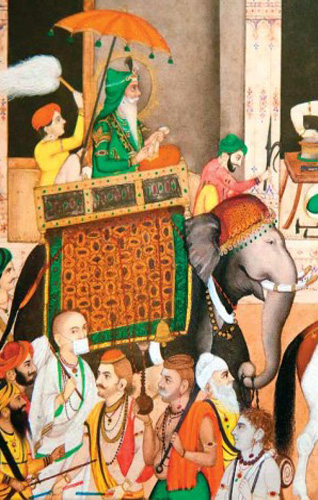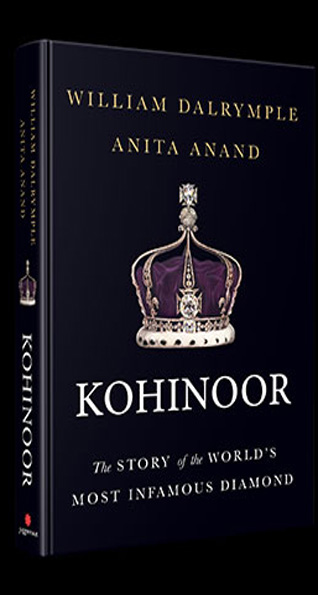Books
Ranjit Singh’s Rock of Power:
The Koh-i-Noor
WILLIAM DALRYMPLE & ANITA ANAND
An excerpt from a new book on the Koh-i-Noor:
KOHINOOR: THE STORY OF THE WORLD’S MOST INFAMOUS DIAMOND, by William Dalrymple and Anita Anand. Juggernaut Books, 264 pages, Rs 499.
The great maharaja of the Sikhs was, in general, a man of unassuming tastes. A diminutive figure with a pockmarked face, he reminded one British observer who saw him in old age of ‘an old mouse, with grey whiskers and one eye’. He dressed in simple white robes and rarely took pains with his appearance. He did, however, love the Koh-i-Noor with a rare passion and wore it on all public occasions.
It was during his reign that the Koh-i-Noor first began to achieve real fame and gained the singular status it has retained ever since: up to this point, as a possession of Nader Shah and his Durrani successors, it had always been worn as part of a pair along with the gem known to the Mughals as the great ruby of Timur, to Nader Shah as the Eye of the Houri and to the Durranis as the Fakhraj. Now the Koh-i-Noor was worn alone, quickly becoming a symbol of all Ranjit Singh had strived for and the independence he had fought so hard to achieve.
It was not just that Ranjit Singh liked diamonds, and respected the stone’s vast monetary value; the gem seems to have held a far greater symbolism for him. Since he had come to the throne he had won back from the Afghan Durrani dynasty almost all the Indian lands they had seized since the time of Ahmad Shah. Having conquered all the Durrani territories as far as the Khyber Pass, Ranjit Singh seems to have regarded his seizure of the Durrani’s dynastic diamond as his crowning achievement, the seal on his status as the successor to the fallen dynasty. It may have been this, as much as the beauty of the stone, that led him to wear it on his arm on all state occasions.
When Ranjit Singh first took the great diamond in 1813, he suspected that Shah Shuja may have tried to trick him. So he immediately assembled the jewellers of Lahore to test the stone. There was much relief, and even a little surprise, when they pronounced it genuine, and priceless. As an old courtier later recalled: ‘The Maharaja held a Durbar on his return to the Palace, and the Koh-i-Noor Diamond was exhibited to the Chiefs and people assembled there, and repeated congratulations were offered his Highness on the attainment of this valuable jewel.’
For two days, Ranjit Singh had the diamond carefully examined by the jewellers of Lahore. Then:
[H]aving fully satisfied himself that the diamond which he had obtained from the Shah was the genuine Koh-i-Noor, he sent Shuja a lakh and twenty-five thousand [125,000] Rupees as a donation. The Maharaja then went to Amritsar and immediately sent for the principal jewellers of that City too to ascertain from them their opinion of the value of the Koh-i-Noor. Having carefully examined it, they replied that the value of a diamond of such great size and beauty was far beyond all computation. The Maharaja desired them to set the diamond in a handsome and suitable manner, and this work was executed in his Highness’s presence, for he would not allow them to take the precious jewel out of his sight.
The setting being completed, Ranjit Singh fixed the Koh-i-Noor in the front of his turban, mounted his elephant, and accompanied by sirdars and attendants, paraded several times up and down the principal streets of the City, in order that his subjects might see the Koh-i-Noor in his possession. The Koh-i-Noor was produced and worn by Ranjit Singh as an armlet on the Diwali, the Dusserah, and other great festivals, and it was always exhibited to visitors of distinction, especially to British Officers who visited his Court. Ranjit Singh took the Koh-i-Noor with him wherever he travelled to Multan, Peshawar and other places.
Shortly after this, Ranjit returned to the diamond’s old owners to try, yet again, to get an estimate of its real wealth. Wa’fa Begum told him, ‘If a strong man were to throw four stones, one to each of the cardinal points, North, South, East and West, and a fifth stone vertically, and if the space between were to be filled with gold and precious stones, they would not equal in value the Koh-i-Noor.’ Meanwhile Shah Shuja, when asked the same question, is said to have replied, ‘Good luck for he who has possessed it, has obtained it by overpowering his enemies.’
For the rest of his life, Ranjit Singh remained anxious that his precious jewel would be stolen. He was especially worried that, ‘having partaken freely of his favourite and most potent beverage, as he was wont to do on occasions of great rejoicing, and feeling that his senses were fast yielding to its intoxicating effects, he evinced considerable anxiety for the safety of the Koh-i-Noor; for on a former occasion, when he had been indulging freely in like manner, a valuable jewel had been stolen from him’.
When not being worn, he had the gem hidden away in his high-security state treasury at the impregnable fortress of Gobindgarh, and he evolved an elaborate security regime for moving it from place to place. Forty camels with identical panniers would be assembled and great secrecy was maintained as to which was actually carrying the diamond, although invariably it would actually be placed in the first, immediately behind the guards. At other times the stone would be kept under a strong guard in the Gobindgarh treasury, or toshakhana.
All the while, Ranjit Singh’s state continued to prosper and expand. The maharaja took full advantage of the opportunity presented by the Afghan civil war to absorb almost all of the lands of the Durrani empire between the Indus and the Khyber Pass, conquering Peshawar in 1818, and Kashmir a year later. At the same time he built a remarkably rich, strong, centralised and tightly governed Sikh state in its place, treating defeated chiefs with great generosity, and absorbing them into his political system. As well as creating his remarkable army, Ranjit also modernized his bureaucracy, balanced his revenues, evolved an enlightened agrarian policy, and ran a formidable intelligence network.
Advertisement
At its peak, his kingdom of Punjab and its province of Kashmir formed a unit with around thirteen million inhabitants, and Ranjit Singh seems to have been personally hugely popular: he made himself accessible to the humblest petitioner, respected the beliefs of non-Sikhs, visiting Muslim Sufi shrines and celebrating Hindu festivals, and was respected for his personal leniency and hatred of bloodshed -- something that was observed by many visitors at court, and dramatically distinguished him from most of his Mughal, Persian and Durrani predecessors. As Emily Eden, the sister of the British Governor General Lord Auckland, conceded: ‘He is a very drunken old profligate, neither more nor less. Still he has made himself a great king; he has conquered a great many powerful enemies; he is remarkably just in his government; he has disciplined a large army; he hardly ever takes away life, which is wonderful in a despot; and he is excessively beloved by his people.’
Emily Eden was not alone in her admiration of Ranjit Singh. The British generally got on well with him, but they never forgot that his army was the last military force in India which could take on the Company on the field of battle: by the 1830s, the Company had stationed half the Bengal army, totalling more than 39,000 troops, along the Punjab frontier.
(Excerpt, courtesy Juggernaut Books. Available in bookstores and www.juggernaut.in)
December 15, 2016
Conversation about this article
1: Sangat Singh (Kuala Lumpur, Malaysia), December 18, 2016, 6:52 PM.
I have two of Dalrymple’s books in my library: "Return of a King” and “White Mughals.” These are voluminous, each more than 500 pages. I have not had the courage to read them completely. I can’t even lift them. I suspect his latest book too lives up to his norm of more than 500 pages. In the meantime may we talk about another 'Koh-i-Noor' that Guru Nanak found and gave it to Mardana to go and get it evaluated. He thought maybe someone might buy it for their children to play with it. When he went to the first shop he was offered one radish for it. Next was a sweetmeat seller who offered a kilo of jalebis. The next, a cloth merchant, offered a yard of coarse cloth. The price went on increasing until he went to a goldsmith who paid Rs. 100/- for the glimpse of it. Mardana refused to take the money despite being hungry. Salis Rai, the jeweler, said that 100 rupees was just the price for the glimpse of it. Upon his return, Mardana placed the diamond and 100 rupees before Guru Sahib, and said: “Here is your magic stone. At one place I couldn’t get even two radishes and in another it was invaluable.”




